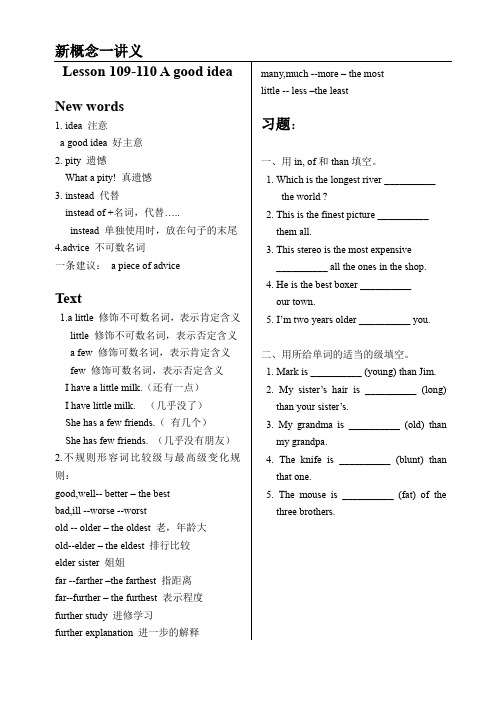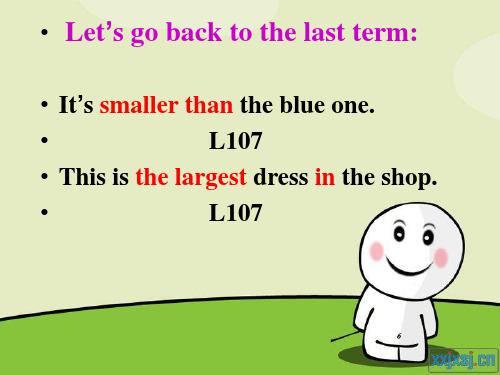新概念英语109课讲义
新概念英语Lesson 109-110讲义

1.a little修饰不可数名词,表示肯定含义
little修饰不可数名词,表示否定含义
a few修饰可数名词,表示肯定含义
few修饰可数名词,表示否定含义
I have a little milk.(还有一点)
I have little milk.(几乎没了)
She has a few friends.(有几个)
She has few friends.(几乎没有朋友)
2.不规则形容词比较级与最高级变化规则:
good,well-- better – the best
bad,ill --worse --worst
old -- older – the oldest老,年龄大
old--elder – the eldest排行比较
2. My sister’s hair is __________ (long) than your sister’s.
3. My grandma is __________ (old) than my grandpa.
4. The knife is __________ (blunt) than that one.
__________ all the ones in the shop.
4. He is the best boxer __________
our town.
5. I’m two years older __________ you.
二、用所给单词的适当的级填空。
1. Mark is __________ (young) than Jim.
Lesson 109-110 A good idea
New words
1. idea注意
新概念英语NCE1_lesson109-110(共25页)课件

little, few, less, least, fewer, fewest
I’ve got little money. I have got less money than you have. I’ve got the least.
I’ve got few books. I have got fewer books than you have.
不规则形容词的比较级 (新1当中出现的)
原级
比较级
good /well better
bad/ill
worse
many/much more
little
less
最高级 best worst most least
形容词比较级和最高级的用法
一般由than引导后面的比较对象。 例:I am younger than you are.
JANE:
I’d like a cigarette, too.
May I have one?
CHARLOTTE: Of course.
I think there are a few in that box.
JANE:
I’m afraid it’s empty.
CHARLOTTE: What a pity!
pity n. 遗憾
e.g. What a pity!真遗憾!
英语中常用“what+a+可数名词”和 “what+不可数名词”来表示感叹。
instead adv. 代替
instead of 代替……
e.g
The pen doesn’t work ,give me that instead.
=Please give me that pen instead of this. 翻译:Have a biscuit instead!
新概念英语1第109课A good idea 课件ppt

【课文】
CHARLOTTE: Shall I make some coffee, Jane? JANE: That's a good idea, Charlotte. CHARLOTTE: It's ready. Do you want any milk? JANE: Just a little, please. CHARLOTTE: What about some sugar? Two teaspoonfuls? JANE: No, less than that. One and a half teaspoonfuls, please. That's enough for me. JANE: That was very nice. CHARLOTTE: Would you like some more? JANE: Yes, please. JANE: I'd like a cigarette, too. May I have one? CHARLOTTE: Of course. I think there are a few in that box. JANE: I'm afraid it's empty. CHARLOTTE: What a pity! JANE: It doesn't matter. CHARLOTTE: Have a biscuit instead. Eat more and smoke less! JANE: That's very good advice!
pity n. 遗憾
feel pity for =take/have pity on 同情 What a pity!
instead
新概念第一册109课(ppt课件)

going by car.
学习交流课件
7
a few 表示可数,几个
There are a few trees。
little 表不可数,几乎没有,表否定
I slept very little last night
few 表可数,几个
Few people understand the difference.
Few students learn La学习t交i流n课件now.
Do you want any milk?
肯定句用“some”,否定句疑问句用
“any”,如果是用在请求的句子里,
some不用变成any。some可修饰可数/
不可数名词。
学习交流课件
3
ห้องสมุดไป่ตู้
Just a little ,please.
a little 表不可数,少许
There is a little water。
lesson 109 A good idea
学习交流课件
1
less 较少的 least 最少的 at least 至少
instead 代替 instead of 代替,后跟动名词 in place of 代替
advice 建议,不可数名词
a piece of advice 一条建议
ask for advise 征求意见
学习交流课件
6
Have a biscuit instead.
用在句末或者句首。 Lee was ill so i went instead.
instead of用在句中,因为of是介词,所 以后跟动名词
We just had soup instead of a full
新概念英语第一册109-110课件

language point : 形容词的比较级和最高级
不规则变化:(多少、好坏) many/much-more-most few/little-less-least
good/well-better-best bad/ill/badly-worse-worst
far-farther/further-farther/furthest old-older/elder-oldest/eldest
I will make some coffee for you. some通常用于肯定句,而在疑问句中要变成any,但 是在征询意见的问句中仍用some。
新概念英语第一册109-110课件
夏洛特:咖啡好了,你要放点奶吗? CHARLOTTE:It‘s ready. Do you want any milk? 简:请稍加一点。 JANE:Just a little, please.
There is little coffee in the cup.
eg.我请老师对我的英语学习给些建议。
The doctor advised me to take a week’s rest.
advise that…
eg. I advised him to stop smoking.
= I advised that he stop smoking.
give sb a piece of advice / offer sb a piece
我因她的无助而觉得她可怜 I pity her for her helplessness.
新概念英语第一册109-110课件
2)v. 令人觉得怜悯,同情 feel pity for =take/have pity on 同情 eg: I pity her for her helplessness.
新概念英语第一册第109-110课课件

★smoke v. 抽烟
• ① v. 抽(纸烟、烟斗等) • He smokes cigars. 他抽雪茄。 • ② v. 冒烟;冒雾气
• She could see a chimney smoking in the nearby village.
• 她可以看到附近村子里的烟囱在冒烟。 • ③ v. 熏制(鱼肉等) • Do you know how to smoke hams? 你知道
★a little 少许 ★a few 几个
• a little 修饰不可数名词,表示肯定含义; • little 修饰不可数名词,表示否定含义
• I have a little milk.
• I have little milk. • a few 修饰可数名词,表示肯定含义; • few 修饰可数名词,表示否定含义
adv. 代替 n. 建议,忠告
★idea n. 主意
• idea 含义较广,主意,想法,各种看法 • I have a good idea. • opinion 对某事具体的看法、观点、想法 • in one's opinion 在我看来 • thought 成系统的思想 • view 侧重个人意见 • viewpoint 观察视点
Lesson 109 A good idea
words
idea pity a little teaspoonful less a few instead advice
n. 主意 n. 遗憾 少许(用于不可数名词之前)
n. 一满茶匙 adj. (little的比较级)较少的,更小的 几个(用于可数名词之前)
decided to become a singer. • ② adv. 代替,而不是(of) • She wanted to have milk instead of juice. • She prefers buying books instead of borrowing them
新概念英语1第109课A-good-idea-课件ppt

little, few, less, least, fewer, fewest
I’ve got little money. I has got less money than you have. I’ve got the least.
I’ve got few books. I have got fewer computers than you have.
I have got the fewest.
不规则形容词的比较级
原级
比较级
good /well better
最高级 best
bad/ill
worse
worst
many/much more
most
little
ther/further farthest/furthest
名词数量的比较
• 变化规则: • 1.一般形容词后直接加est,(tallest) • 2.以元音加辅音结尾的,双写最后一个字母,
再加est,(biggest) • 3.以辅音加y结尾的,变y为i,再加est.
(heaviest). • 4.以e结尾的,直接加st. (largest)
Can you tell me how many books/money you have got?
Lesson 109 A good idea
Topic:
What would you like when you are having coffee? Milk? Sugar? Cigarette? Biscuit?
A piece of advice Eat more and smoke less!
language points
practice
新概念1 Lesson109-110 课件

肯 a little
定 a few 否 litless adj. (little的 比较级)较少的,
更小的
less than…
least adj.
(little的最高级)最小的,最 少的
It’s too small.
ASSISTANT: Do you like this dress, madam?
LADY:
I like the colour very much.
It's a lovely dress, but it's too small for me.
ASSISTANT: What about this one?
• instead [in'sted] adv.代替 • I don’t have any beer. • I would like to have a cup of coffee, instead.
• advice [əd‘vais] n.建议,忠告 [U] • 一条建议 • a piece of advice
比较级 better更好的
bad差的,ill坏的
worse更差的;更坏 的
many/much多的
more更多的
little少的
less更少的
最高级 best最好的 worst最差的;
最坏的 most最多的
least最少的
比较级和最高级的构成
不规则变化
原级
比较级
最高级
old 年老的; older较老的;较旧的 古老的
Lesson 109 A good idea
新概念英语第一册109-110课课件上课讲义

advice建议(不可数名词)
• 一条建议 • a piece of advice • 给我一些建议 • Give me some advice. • 那是个好建议。 • That’s very good advice.
2020/6/24
• pity ['piti] n.遗憾 • What a pity!
2020/6/24
Watch the video and then answer the question:
• What does Jane have with her coffee?
2020/6/24
special
• good(well) • -better-the best • bad(ill) • -worse-the worst • many/much • ---more---the most • little 2•020/-6/-24-less--- the least
2020/6/24
ห้องสมุดไป่ตู้
将下列句子改为感叹句
• 1. He is a clever boy. • What a clever boy he is! • 2. This is a lovely dress. • What a lovely dress this is! • 3. It is an interesting film. • What an interesting film it is!
乎没有”(悲观)
• There is a little juice in the glass. • There is little juice in the glass.
• less [les] adj.(little的比较级)
新概念美音版第一册原版-C109【声音字幕同步PPT】

It doesn't matter.^没关系。 Have a biscuit instead.^那就吃块饼干吧。
Eat more and smoke less!^多吃点,少抽点! That's very good advice!^这是极好的忠告啊!
than that.^不,再少一些。 One and a half teaspoonfuls, please.^请放
一勺儿半。
That's enough for me.^那对我已足够了。 That was very nice.^太好了。
Shall I make some coffee,Jane?^我来煮点咖 啡好吗,简?
That's a good idea, Charlotte.^这是个好主意, 夏洛特。
It's ready.^咖啡好了, Do you want any milk?^你要放点奶吗?
Just a little, please.^请稍加一点。 What about some sugar?^加些糖怎么样?
--- end
Would you like some more?^你再来点吗? Yes, please.^好的,请再来一点。
I'd like a cigarette, too.^我还想抽枝烟。 May I have one?^可以给我一枝吗? Of course.^当然可以。
I think there are a few in that box.^我想那个 盒子里有一些。
新概念美音版第一册原版-C109
--- lesson 109 A good idea 好主意
新概念英语第一册Lesson109课件(共44张PPT)

新概念英语第一册Lesson109课件(共44张PPT)(共44张PPT)What are the people talking aboutWhat are the people talking aboutThey are talking about coffee.What does Jane have with her coffeeWhat does Jane have with her coffeeJane has a biscuit with her coffee.n. 主意What a good idea! 多好的主意啊!idea [a d ]英文习语:①have no idea丝毫不知道What's she talking about 她在讲什么?I have no idea. 我一点也不了解。
n. 主意What a good idea! 多好的主意啊!idea [a d ]英文习语:② that's the idea! 干得好;做得对That's the idea! You're doing fine.对啦!你做得不错。
少许(用于不可数名词前)She needs a little water. 她需要一点水。
a littlea little 可以当副词用,意为“略微,稍微” ,表示程度不深。
It is a little cold today.今天有点儿冷。
n. 一满茶匙Put a teaspoonful of salt in the soup.往汤里放一满茶匙盐。
teaspoonful [ ti spu nf l]近义词:teaspoon n.茶匙;小匙;一茶匙(的量)He wants three teaspoons of sugar in his coffee. 他要在咖啡里放3茶匙的糖。
adj. (little的比较级)较少的,更小的less [les]I want less sugar for my coffee.我的咖啡要加少些糖。
新概念英语第一册109-110课课件(共46张PPT)

advise v. 忠告,劝告,建议
advise sb to do sth
劝告某人做某事
医生建议我休息一周
The doctor advised me to take a week’s rest.
He has few friends. 他有一些 朋友
He has a few friends. in a few days 过几天 她过几天会回来
She will come back in a few days.
only a few 仅少数,只有几个… 房间中只有几个男性。
Only a few men were in the room.
This story is less interesting. 考试以后,他学习更不努力了。
After the exam, he works less hard.
more or less
a few 几个 (通常置于可数名词之前) few 和a few
few是“几乎没有”的否定性意见 a few 是“有一些”的肯定性意见。 他几乎没有朋友
There is a little wine left in the bottle. 瓶子里没剩下多少酒。
There is little wine left in the bottle.
teaspoonful n. 一满茶匙
一茶匙的糖 a teaspoonful of sugar
mouthful n. 一满嘴
我不喜欢金钱就是一切的想法
I don’t like the idea that money is everything.
关于这件事你的意见如何
- 1、下载文档前请自行甄别文档内容的完整性,平台不提供额外的编辑、内容补充、找答案等附加服务。
- 2、"仅部分预览"的文档,不可在线预览部分如存在完整性等问题,可反馈申请退款(可完整预览的文档不适用该条件!)。
- 3、如文档侵犯您的权益,请联系客服反馈,我们会尽快为您处理(人工客服工作时间:9:00-18:30)。
Lesson 109 a good idea讲义重点
一、本课重要单词
Idea:主意;意见,见解,想法;
That's a good idea. 那是一个好主意。
What is your idea about it? 关于这件事你的意见如何?
a little:少许,有一点,表示肯定意义;
little:几乎没有,很少,表示否定意义。
little与a little修饰不可数名词。
There is a little wine left in the bottle. 瓶子里还剩一点酒。
There is little wine left in the bottle.瓶子里没剩下多少酒。
teaspoonful: 一满茶匙;a teaspoonful of sugar 一茶匙糖; less: 较少的,更少的,是little和few的比较级。
a few:一些,几个;few:几乎没有;few和a few主要用来修饰可数名词;例:
A few children were in the room. 房间里有几个孩子。
Few children were in the room.房间里几乎没有孩子。
pity:遗憾; What a pity! 真可惜,实在可怜。
Instead:代替;掌握关于instead的一个重要短语,instead of 代替….,而不…..
I have to finish my work instead of going out.
我必须完成工作而不是出去玩。
advice:建议,忠告;掌握关于advise的短语,give some advice:提出建议;take the advice 听取建议;
二、本课重要知识点
1. I think there are a few in that box.
我想那个盒子里有一些。
在本句中需要掌握there be句型及few/little的用法:
(1)there is+可数名词的单数或不可数名词,例:
There is some water in the bottle.瓶子里有一些水。
(2)there are+可数名词的复数,例:
There are a lot of children in the classroom.
教室里有很多孩子。
(3)a few:一些,几个,肯定意义,表示“有”的意思,few:很少,否定意义,表示“没有”,few/a few均修饰可数名词:I met a few of my friends in Paris.
在巴黎我碰见我的几个朋友。
Few of us know the truth.我们中几乎没有人知道真相。
(4)a little:有一点,有一些,肯定意义,表示“有”的意思;little:很少,几乎没有,否定意义,表示“没有”,little/a little 均修饰不可数名词:
Come in and have a little milk. 进来喝点牛奶。
We got little help from them.
我们没有从他们那儿得到什么帮助。
2.本课重要语法:可数名词与不可数名词
英语中名词分为可数名词与不可数名词两种,可数名词是指可以用数目计算的名词。
可数名词有单复数之分。
不可数名词是指不可以用数目计算的名词,不可数名词没有单复数之分。
不可数名词在表示“一个”的概念时,就必须用表示量的名词词组,例:a piece of paper:一张纸;a piece of news:一条新闻;a piece of cheese 一块乳酪;a bar of chocolate 一块巧克力;等等。
最常见的不可数名词有:advice, change(零钱), furniture(家具), hair, homework, information(信息), knowledge, luggage (行李), money, news, progress, traffic等等;
可数名词与不可数名词用法如下:
(一)可数名词的用法:
可数名词有单数和复数两种形式。
指一个人或一件事物时,用单数形式;指两个或多个人或事物时用复数形式。
名词由单数形式变成复数形式的规则变化如下:
①大多数的可数名词的复数形式,是在该词末尾加上后辍-s。
例:friend→friends; cat→cats;
②是以s、x、ch、sh结尾的词,在该词末尾加上后辍-es,构成复数。
例:bus→buses; fox→foxes; match→matches;
③以辅音字母+y结尾的名词,将y改变为i,再加-es。
例:family→families;fairy→fairies; lady→ladies;
④以-o结尾的名词,一般直接加s,例:
zoo →zoos; radio →radios;
video →videos; piano →pianos; photo →photos;
以下几个一般常加-es: 黑人Negro英雄hero喜欢吃西红柿tomato和马铃薯potato。
⑤、以-f或-fe结尾的名词,多为将-f或-fe改变为-ves,例:knife→knives; life→lives;
leaf→leaves; staff(员工)→staves;
不规则变化:
child---children foot---feet tooth---teeth
mouse---mice man---men woman---women;
deer---deer,sheep---sheep,fish---fish,Chinese---Chinese,Japanese---Japanese;
(二)不可数名词的用法:
(1)不可数名词不能与a/an连用而且没有复数形式,只有单数形式,some bread,a little milk,a little water; some soup;(2)不可数名词作主语,谓语动词用作单数,即使与some/any等连用也是单数形式,例:
The food is very fresh.食品很新鲜。
There is some milk in the cup:杯子里有一些水;
There is not any water in the bottle:瓶子里没有水了;
(3)不可数名词经常需要“量化”,量化后的单复数是由量词来决定的,例:
There is a bar of chocolate on the plate.
盘子里有一块巧克力。
There are two cups of tea on the table.
桌子上有两杯茶。
There are three bottles of milk in the fridge.
冰箱里有三杯牛奶。
(4)对可数名词前的修饰语提问用how many; 对不可数名词前的修饰语提问用how much。
例:
How many apples are there in the box?
盒子里有多少个苹果?
How much tea is there in the cup?
杯里有多少茶水?。
